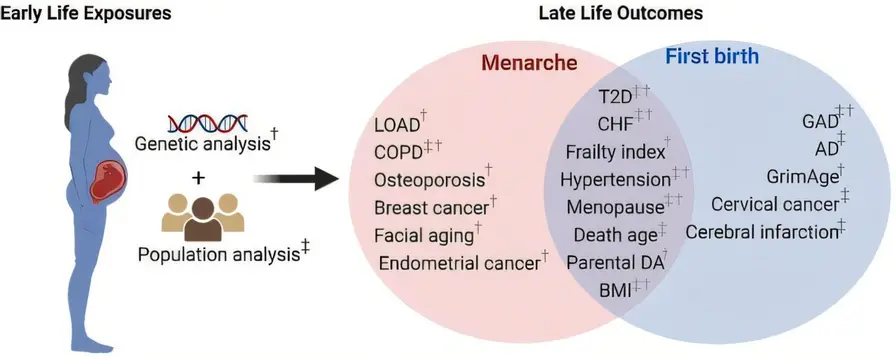T4K3.news
Study links early reproductive timing to aging risks
New findings connect early puberty and childbirth with higher long-term disease risk, suggesting new angles for health monitoring.

A Buck Institute study using UK Biobank data finds that early puberty before 11 and childbirth before 21 are associated with higher risks of metabolic diseases and may influence aging.
Early puberty and early childbirth linked to higher aging risks
A study now online at eLife reports that girls who reach menarche before age 11 or women who give birth before 21 have about double the risk of type 2 diabetes, heart failure, and obesity, and four times the risk of severe metabolic disorders. The research analyzed nearly 200,000 women in the UK Biobank and identified 126 genetic markers mediating these effects. The authors frame the findings in terms of antagonistic pleiotropy, a theory that traits helping young individuals survive can carry costs later in life.
Methodologically, the work relies on regression analyses and genetic data, offering clues about pathways such as IGF-1, growth hormone, AMPK and mTOR signaling. The authors caution that the study cannot prove causation and that BMI acts as a key mediator, suggesting that lifestyle and weight management may influence long-term risk. They also note that later puberty and childbirth are genetically associated with longer lifespan and slower epigenetic aging, hinting at a nuanced picture of aging that blends biology with life history.
Key Takeaways
"Even though women are routinely asked about their menstrual and childbirth history when they receive medical care, this information has rarely factored into the care they receive outside of OB/GYN."
Clinical practice gaps in using reproductive history for risk assessment
"If evolution has shaped us to prioritize early reproduction at the cost of aging, how can we leverage this knowledge to extend health span in modern society?"
Editorial prompt on applying findings to public health
"We identified 126 genetic markers that mediate the effects of early puberty and childbirth on aging"
Report of genetic findings
"These risk factors, whether positive or negative, clearly have significant influence on a variety of age-related diseases"
Reflection on broad health impact
The study sits at the intersection of biology and behavior. It uses large-scale data to connect early reproduction with later disease risk via multiple pathways, but it remains observational. That caveat matters: correlation is not proof of causation, and lifestyle factors like BMI appear as a mediator that could be addressed through public health measures.
The real test is whether health care systems will integrate reproductive history into risk assessments without stigmatizing mothers or overlooking socioeconomic factors. As trends shift toward earlier puberty in some populations, researchers argue the data should inform prevention and screening rather than blame. The work also highlights a broader truth: evolution can set tradeoffs that modern life must learn to manage.
Highlights
- Genetic tradeoffs shape health from youth to old age
- Later puberty could reveal clues for healthier aging
- Health care should consider reproductive history in risk assessments
- Understanding these tradeoffs empowers personal health decisions
As science clarifies these tradeoffs, health care can move toward more personalized, preventive strategies.
Enjoyed this? Let your friends know!
Related News

Covid linked to faster vascular aging

Stroke risk linked to pregnancy history

Surge in egg donations raises health concerns

Study reveals poverty's impact on women's memory decline

Smartphone Use Before Age 13 Linked to Mental Health Issues

New research reveals dementia risks for autistic individuals

Early screenings rise among 45 to 49

Dexter software highlights link between childhood trauma and health risks
